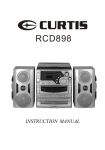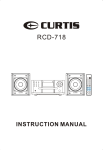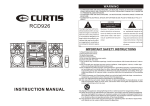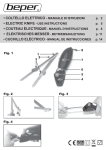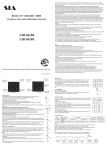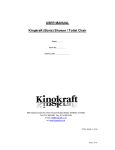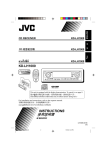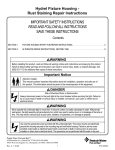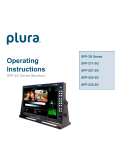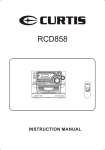Download Sylvania SRCD904 CD Player User Manual
Transcript
SRCD904 WARNINGS TO Prevent fire or shock hazard, do not use this plug with an extension cord, receptacle or add other outlet unless the blades can be can be fully inserted to prevent blade exposure. To prevent fire or shock hazard, do not expose this appliance to rain or moisture. WARNING The lightning flash with arrowhead symbol,within an equilateral triangle is intented to alert the user to the presence of uninsulated' dangerous voltage' within the product's enclosure that may be of sufficient magnitude to constitute a risk of electric shock to persons. CAUTION : TO REDUCE THE The exclamation point within RISK OF ELECTRIC SHOCK an equilateral triangle is int- DO NOT REMOVE COVER ( ended to alert the user to the OR BACK),NO USER SERV- presence of important opera- ICEABLE PARTS INSIDE R- ting and maintenance (servi- EFER SERVICING TO QUA- cing) instructions in the liter- LIFIED SERVICE PERSON- ature accompany-ing the ap- NEL plicance IMPORTANT SAFETY INSTRUCTIONS 1 Read these instruction. 2 keep these instructions. 3 heed all warnings. 4 Follow all instructions. 5 Do not use this product near water(swimming pool, beach, lake etc.). 6 Clean only with a dry cloth. 7 Do not block any of the ventilation openings.Install in accordance with the manufacturer's instructions . 8 Do not install near any heat sources such as radiators, heat registers . Stoves or other apparatus (including amplifiers)that produce heat. 9 Do not defeat the safety purpose of the polarized or grounding-type plug, A polarized plug has two blades with one wider than the other. A grounding type plug has two blades and a third grounding prong. The wide blade or the third prong is provided for your safety. If the provided plug does not fit into your outlet, consult an electrician for replacement of the obsolete outlet. 10 Protect the power cord from being walked on or pinched particularly at receptacles and the point where they exit from the stereo. 11 Only use attachments/accessories specified by the manufacturer. 12 Unplug this apparatus during lightning storms or when unused for long periods of time 13 Refer all servicing to qualified service personnel. Servicing is required when the system has been damaged in any way, such as a damaged power-supply cord or plug . Has been exposed to rain or moisture ,does not operate normally , or has been dropped. 14 This appliance should not be exposed to dripping water or splashing water and objects filled with water, such as vases, should not be placed on this unit English 1 2 English SRCD904 SRCD904 MINI HIFI SYSTEM WITH TURNTABLE, 3-CD CHANGER, AM/FM-STEREO RADIO, DOUBLE AUTOSTOP CASSETTE AND REMOTE CONTROL. 20 18 19 22 21 INSTRUCTION MANUAL Please read this instruction manual carefully and familiarize yourself with your new Hifi System before using it for the first time. Please retain this manual for future reference. TABLE OF CONTENTS • Location and Controls-------------------------------------------------------- 3 • Connecting to Power----------------------------------------------------------- 4 • Power Supply---------------------------------------------------------------------- 4 • Connections ------------------------------------------------------------------- 4 • Tuner Operation------------------------------------------------------------------ 5 • Cassette Operation ----------------------------------------------------------- 5 • To Record on a Cassette -------------------------------------------------- 6 • Sound adjustments --------------------------------------------------------- 7 • Compact Disc Operation ---------------------------------------------------- 8 • Track Skip ------------------------------------------------------------------- 9-10 • Manual Search ---------------------------------------------------------------- 10 • Repeat ------------------------------------------------------------------------ 11 • Disc programming ----------------------------------------------------11-12 23 17 24 25 16 15 14 13 12 11 10 9 3-8 • Turntable ------------------------------------------------------------------------- 12 • Remote control -------------------------------------------------------------- 13 2 • Important ------------------------------------------------------------------------------ 14 • Specifications ------------------------------------------------------------------------ 16 1 26 27 28 29 30 31 32 33 - 37 38 39 English LOCATION OF CONTROLS 1. 2. 3. 4. 5. 6. 7. 8. 9. 10. 11. 12. 13. 14.. 15.. 16.. 17.. 18.. 19.. 20. 21. 22. 23. 24. 25. 26. 27. 28. 29. 30. 31. 32. 33. 34. 35. Mains Lead , Speaker Sockets and FM Antenna wire ( at the rear of the unit ) CD Tray RECORD Key PLAY Key REWIND Key FAST FORWARD Key STOP / EJECT Key PAUSE Key CASSETTE Compartment A DISC SKIP Button CD REPEAT Button PROGRAM Button PHONES Socket FUNCTION Selector (Phono/Tuner/Tape/CD) CD STOP Button STANDBY/ON Button PRESET EQUALIZER Button FM-STEREO Indicator STANDBY/Mute Indicator EQ Indicators LCD Display REMOTE Sensor Turntable (PHONO) VOLUME Up/Down Button DIAL Pointer HIGH SPEED DUBBING/ FM Stereo Selector CD PLAY/PAUSE Button RADIO Band wave selector TUNING Knob CD Skip/Search Forward Button CD Skip/Search Backward Button INTRO Button CASSETTE Compartment B PLAY Key REWIND Key FAST FORWARD Key 3 4 English 36. 37. 38. STOP / EJECT Key PAUSE Key CD OPEN / CLOSE Button 39. CD DIRECT Access - 1, 2, 3 CONNECTING TO POWER Before switching on make sure that the voltage of your electricity supply is the same as that indicated on the rating plate. For your own safety read the following instructions carefully before attempting to connect this unit to the mains. MAINS (AC) OPERATION This unit is designed to operate on AC 120V 60Hz current only. Connecting it to other power sources may damage the unit. CAUTION To prevent electric shock disconnect from the mains before removing cover. No user serviceable parts inside. Refer servicing to qualified service personnel. POWER SUPPLY Remove the stereo carefully from the box, retaining the packaging for future use. AC POWER OPERATION Connect the plug to a mains power inlet 120V AC ~ 60 Hz. CONNECTIONS SPEAKER CONNECTION Connect each speaker to the corresponding speaker terminals on the back of the system. Ensure that the left speaker is connected to the left connector, and the right speaker to the right connector. HEADPHONE This unit will accept stereo headphones (not included) with a 3.5mm plug and an impedance of 8 ohms or greater. The speakers are automatically disconnected when headphones are connected to the PHONES JACKS (13). English 5 AM/FM TUNER OPERATION • Press the STANDBY/ON Button (16) to ON . The Standby indicator (19) will go off. • Set the Function Selector (14) to the TUNER position. • Select the desired frequency band with the Band Selector (28). • Tune to the desired radio station by turning the Tuning control (29). • Press the STANDBY/ON Button to OFF. ANTENNA • For FM reception there is a built-in FM antenna wire at the rear of the unit. Move the wire around to obtain the best reception. • For AM reception the signals are picked up through a built-in ferrite antenna. Your may have to orient the unit to obtain the best reception. 6 • English Press the Stop / Eject Key (36) when finished. Otherwise the tape will stop automatically when the end of the tape is reached. CONTINUOUS PLAYBACK ( ONLY RUNNING FROM TAPE DECK B TO A ) • Set the Function Selector (14) to the TAPE position. • Insert your cassette tapes. • Press the PLAY Key (33) of deck B. • Press the PAUSE Key (8) and the PLAY Key (4) of deck A. • Deck B will now proceed to play its side. • Adjust the VOLUME (24) control to the preferred level. • When Tape Deck B has finished playing, it will stop. Tape Deck A then starts playing back automatically. • When Tape A reaches its end, it automatically stops. RECORDING (ONLY ON TAPE DECK A) FM & FM-STEREO RECEPTION • Stereo reception is possible when the tuned FM station is broadcasting in stereo. • When the FM Stereo button (26) is “up” and the station is broadcasting in Stereo, the STEREO indicator (18) lights up. • When FM stations are weak and are disturbed, listening can be improved by pressing down the FM STEREO selector (26). Reception will then be in MONO. CASSETTE OPERATION INSERTION AND REMOVAL OF CASSETTES • Press the STANDBY/ON Button (16) to ON . The Standby indicator will go off. • Set the Function Selector (14) to the TAPE position. • Press the Stop / Eject Key (36) to open the Cassette Door of Compartment B. • Slip your cassette tape into the door, with the exposed section facing downward and side A with full spool of tape on left side facing you. • Close the Cassette Door securely. • When finished, press the Stop / Eject Key to open the Cassette Door, and retrieve your cassette tape. PLAYBACK • Set the Function Selector (14) to the TAPE position. • Insert your cassette tape in the Compartment B. • Press the Play Key (33) to activate playback. • Use the Pause Key (37) whenever you want to suspend playback. • • This unit has Automatic Level Control circuitry. This means that the recording level is set automatically. The volume or tone controls will not affect the recording. Record Key will not be pressed down when the record prevention tab is broken or removed from the tape. RECORDING FROM THE RADIO • Set the Function Selector (14) to the TUNER position. • Tune in your station using the TUNING Control (29) and put in your blank cassette tape in cassette compartment “A” (9). • Press the Record Key (3) and the Play Key (4) at the same time on Tape Deck A to start recording. • Press the Stop / Eject Key ( 7) when finished. Otherwise the tape will stop automatically when the end of the tape is reached. RECORDING FROM THE CD • Set the Function Selector (14) to the CD position. • Put in your blank cassette tape in cassette compartment “A” (9). • Select the CD (1,2 or 3) you want to play/record with the Disc Selector button (39). Press the Record Key (3) and the Play Key (4) at the same time on Tape Deck A to start recording. Press Play/Pause Key (27) on the CD player. • Press the Stop / Eject Key ( 7) when finished. Otherwise the tape will stop automatically when the end of the tape is reached. English 7 8 English SYNCHRONIZED TAPE-TO-TAPE RECORDING NORMAL SPEED TAPE-TO-TAPE RECORDING • Insert a fully rewound prerecorded cassette into Tape Deck B. • Insert a fully rewound blank cassette tape into Tape Deck A. • Set the Function Selector (14) to the TAPE position and keep the DUBBING Selector (26) in the “high” position. • Press the Pause Key of Tape Deck “A”, and then press both the Play and Record keys of Tape Deck “A”. • Press the Play Key of Tape Deck “B”. The contents of the tape in Deck “B” will now be copied onto the tape in Deck “A”. • Adjust the Volume Control to the desired levels for monitoring purposes. The recording will be unaffected by changes in these control. • To stop recording, press both of the Stop / Eject Keys. Otherwise the tape will stop automatically when the end of the tape is reached. • To remove a disc from its storage case, press down on the centre of the case and lift the disc out, holding it carefully by the edges. • HIGH SPEED TAPE-TO-TAPE RECORDING • Press down the DUBBING Button (26) to the “low” position. • Follow the steps described above for Normal Speed Tape-to Tape Recording. You will hear the speeded up tape play through the speakers. Turn down the volume to silence the sound. NOTES: If the length of the tape in Deck B is shorter than that in Deck A, the Play Key of Deck B will be released automatically at the end of the tape. Tape A will continue to record until the tape reaches its end, or its Stop / Eject key is pressed. If the length of the tape in Deck A is shorter than that in Deck B. The Record and Play Keys of Deck A will be released automatically at the end of tape. Tape B will continue to play back until the tape reaches its end, or its Stop / Eject Key is pressed. • Fingerprints and dust should be carefully wiped off the disc’s recorded surface with a soft cloth. Unlike conventional records, compact discs have no grooves to collect dust and microscopic debris so gently wiping with a soft cloth should remove most particles. Wipe in a straight line from the inside to the outside of the disc. Small dust particles and light stains will have absolutely no effect on reproduction quality. Never use chemicals such as record sprays, antistatic sprays, benzine, or thinners to clean compact discs. These chemicals can irreparably damage the disc’s surface. Discs should be returned to their cases after use. This avoids serious scratches that could cause the Laser pickup to skip. Do not expose discs to direct sunlight, high humidity, or high temperatures for extended periods. Long exposure to high temperatures can warp the disc. Do not stick paper or write anything with a ballpoint pen on the label side of the disc. SOUND ADJUSTMENT • Press the PRESET EQ button (17) to select between pre-adjusted equalizations. The indicator of the selected type will light up (20): • To Mute the sound instantly press the MUTE Button (7) on the Remote control. The MUTE (19) indicator lights up and flashes . Pressing this button again or pressing the VOLUME buttons on the remote Control, will switch the sound on again. HANDLING COMPACT DISC • • • COMPACT DISC OPERATION LOADING AND UNLOADING COMPACT DISCS • Press the STANDBY/ON Button (16) to ON . The Standby indicator (19) will go off. • Set the Function Selector (14) to the CD position. • Press the OPEN/CLOSE (38) button to open the CD drawer. Note: You do not have to wait for the changer to search all three pockets for Ds. You may open the CD drawer immediately. • The CD pockets are numbered “1,2 and 3”. These numbers correspond to the disc indicators in the CD display. The disc indicators do not change position. However the disc symbol will flash to show which disc is in the play position. Place up to 3 CDs in the pockets of the tray. Place the disc you want to play first in pocket no. 1. Place the disc you want to play second in pocket no.2 and so on. To load three CDs in the tray it will be necessary to rotate the tray to expose the third pocket. After you load the first two discs press the Disc Skip (10) button to rotate the tray and then load English • • 9 your third disc. The discs must be centered in the pockets and loaded with the printed sides facing up. If the disc is not properly centered in the pocket, it may move when you close the drawer. This could jam the mechanism or possibly damage the disc, so be sure to load the disc properly. After you have loaded up to 3 CDs press the OPEN/CLOSE button (38) to close the drawer. The changer will read the information of the CD that is in the play position. The display will show the total number of tracks and total playing time of the disc.One of the 3 disc indicators will be blinking to show you which disc is in the play position. To begin playback of the disc, simply press the PLAY/PAUSE >II button (27). The changer will search all three pockets until it locates the disc and then playback will begin. If no discs are found “disc” will blink on the display. Playback begins with track 1 of the first disc and continues until the final track on disc 3 has been played. During playback the disc indicator of the disc that is played will flash. When the last track of the last CD has been played, the changer stops and the display will show the total tracks and playing time of the first disc again. Notes: If the disc is deeply scratched, or too dirty, disc play may not start. If on improperly centred disc is played, noise can be heard in the mechanism. The use of such discs should be avoided. IMPORTANT INFORMATION This compact disc player has built-in error compensation circuits to correct for minor defects in a disc. There are limits, however, to the amount of correction available. In some cases, the CD player may skip some tracks on a disc during disc play. This problem may be cause by defects (such as scratches) in the disc being played, which are too large for the error compensation circuits to handle. If you encounter this problem, check the CD player’s operation as follows, before having the unit serviced: Play a new disc. If the CD player operates normally, the skipping problem is probably due to a defective disc. TO STOP A CD PART WAY THROUGH • Press the Stop button (15). Disc play will stop, and the display will show the total number of tracks for the CD. • To temporarily stop disc Play (Pause mode), press the Play / Pause button (27) . Disc play will pause at the current play position. The PAUSE indication on LCD will appear. • To resume disc play, press the PLAY / PAUSE button again. The PAUSE indicator will disappear. TRACK SKIP 10 English STARTING DISC PLAY FROM THE BEGINNING OF A PARTICULAR TRACK • Press the Forward or Reverse Skip Track buttons UP/DOWN (30) to select the desired track. The number of the selected track will be shown on the CD display. Press the Play/Pause button to start play. TO SKIP TO THE NEXT TRACK ON A DISC • For example, to skip ahead to the beginning of the next track . • Press the UP Track button once. Disc play will resume at the beginning of the next track. The CD player will skip ahead to the next track each time the UP button is pressed. Continuously pressing the UP Track button makes the CD player skip ahead through the disc track by track. Once the beginning of the last track is reached the CD player will advance to the first track again. TO SKIP BACK TO THE PREVIOUS TRACK ON A DISC • For example to skip back to the beginning of the previous track. • Press the DOWN button twice. If this button is pressed in the middle of a track, the CD player will skip back to the beginning of that track. To make it skip back to the previous track press the DOWN Button twice. Continuously pressing the DOWN button makes the CD player skip back through the disc track by track. Once the beginning of the first track is reached, the CD player will not go back any further. Notes: The Skip Forwards and Backwards buttons can be used to select a desired track to play from before disc play starts. In this case the number of the selected track will be displayed until the Play / Pause Button is pressed. MANUAL SEARCH • During playback, pressing the UP or DOWN Search buttons (30) will cause the player to scan through the current track. At the end of a track the player will skip to the next track and continue scanning. At the beginning of a track the player will skip to the previous track and continue scanning. • When the player reaches the end of the final track, or the beginning of the first track, it will stop scanning. INTRO SCAN • Press the INTRO BUTTON (31) in STOP mode to play the first 10 seconds of each track on the CD. The heading “INTRO” will appear in the display before the track playing. Press this button again, when a desired track is playing, to resume normal playback. “INTRO” will disappear from the display. English 11 12 English 02 d2:00 REPEAT PLAY MODES Choose the disc you want to repeat first. There are 3 repeat options for your convenience. Pressing the REPEAT button (11) in STOP mode will cycle the changer through the three modes as follows: DISPLAY MODE REPEAT ALL DISC Repeats All the Tracks on All the Discs REPEAT 1 DISC Repeats all the tracks on the Current disc. REPEAT 1 Repeats the current track on the Current disc. To cancel a repeat mode, keep pressing the REPEAT Button until the REPEAT Indicator is extinguished. If the REPEAT button is pressed during PLAY mode, then all tracks of that disc will be repeated. PROGRAMMED PLAYBACK The CD changer has a 32 track programmable memory that allows you to program up to a total 32 tracks on 3 discs for playback in any order you choose. You may also program a specific track to be played more than once in a program sequence. To perform programmed playback proceed as follows: • Open the CD drawer and insert up to 3 discs in the tray, then close the drawer. • Select the first disc you wish to program by pressing the appropriate disc number button (for example disc 2) of which you want to program the first track (for example track no. 5). • and “EDIT” will blink. This indicates that the memory is ready to accept the first disc and track to be programmed. Select the first track you wish to programm by pressing SKIP FORWARD button until the desired track appears in the display. 01 d2:05 • NOTE: • If you press the skip buttons during programmed playback the player skips forward or back to the next programmed track, not the next track on the disc being played. • After the last programmed track has been played the player stops but the program remains in the memory. If you press the PLAY/PAUSE >II button again the program will be repeated. • To cancel programmed playback, press the STOP button (15) twice. The program can also be canceled by opening the CD drawer, or by switching the POWER button (16) to “OFF”. To confirm the programmed info After you have entered the last track of your program into the memory you may confirm the program steps if desired. Press the PROGRAM button (12) once more and the display will show the programmed tracks . TURNTABLE OPERATION Press the PROGRAM button (12) once. The display will show “PROGRAM ” 01 d2:- - • • • Select the track you wish to programm by pressing SKIP FORWARD button until the desired track appears in the display. Repeat the above steps until you have entered up to 32 tracks into the memory. When you are finished programming press the PLAY/PAUSE >II button (27) to begin programmed playback. The PROGRAM indicator appears in the display and the changer will play back the tracks and the discs in the order in which you entered them in the program memory. When the display correctly shows the first disc and track number you wish to program, press the PROGRAM button (12) again to enter the disc number and track number in the memory. The display will show Preparation Open the Record Player Cover. Release the Tonearm Clamp, and remove the stylus protector. Listening to Records Set the Function Selector (14) to the PHONO position. Place a record on the turntable, over the central spindle. Place the EP adapter over the central spindle when playing 17cm EP records. 3. Set the Speed Selector Button to 33 or 45 rpm according to the record. 4. Release the tonearm clamp, and remove the protective cap from the stylus. 5. Lift the Tonearm with the Tonearm Lift Lever. 6. Move the tonearm to the beginning of the record, or to the start of a particular track. English 13 7. Gently lower the tone arm onto the record with the Tonearm Lift lever to start playing. 8. When the record is finished the turntable will automatically stop. 9. To stop the record whilst it is playing. Press the Stop Button, The the turntable will automatically will stop. 14 • English make sure that there are no obstacles between the remote sensor and the remote control unit. If you press the MUTE button (7), the sound will be muted. Repress MUTE or the VOLUME controls to return to normal sound level. Notes: Do not stop or turn the platter manually. IMPORTANT Moving or jarring the turntable without securing the Tonearm clamp could result in damage to the Tonearm. Replace the protective cap on the stylus when not in use. REMOTE CONTROL UNIT PREPARATION BEFORE USE 1. 2. 3. Remove the battery cover from the back of the remote control unit. Insert two “AAA” size batteries (not included). Insert the batteries with the + and - terminals matching the indication inside the battery compartment. Replace the cover. 1. Standby/On Button 2. Stop Button 3. Play/Pause Button 4 6 7 5 3 2 1 4. CD Skip Forward / Backward Button 5. Program Button 8 6. Disc Button 7. Mute Button 8. Volume Up/Down Button BATTERY REPLACEMENT When the remote control operation becomes unstable or the distance from which remote control is possible becomes shorter, replace the batteries with new ones. USING THE REMOTE CONTROL UNIT • To use remote control unit, point it at the remote sensor (22) and press the button gently and frimly. Remote control is possible within about 5m (approx. 16FT). However, since the remote control range is less when the unit is used at an angle, use directly in front of the remote sensor, as far as possible. • Do not expose the remote sensor to strong light (direct sunlight or artificial lighting) and Since movement of the CD mechanism and the sensitive circuitry may cause interference to a radio tuner nearby switch this unit off while operating other radio devices. This product utilizes a laser Danger - Invisible laser radiation when opened and interlock failed or defeated. Avoid direct exposure to the beam. Caution - Use of controls, adjustments, or procedures not listed in this manual may result in hazardous radiation exposure. Concerning Compact Discs Only compact discs identified with this mark can be used with this player. English 15 16 English AC CONNECTION CASSETTE CARE Two common causes of trouble experienced when using cassettes are:— (a) Tape jamming — Leading to uneven speed in playback, and (b) Tape tangling — Where the tape wraps itself around vital parts of the mechanism. To reduce the likelihood of these problems occurring, the following precautions should be observed. Check that there are no loose layers of tape visible through the cassette centre window (see Fig. 1). Take up any loose layers, using a pencil or hexagonal barrelled ballpoint pen, before inserting the cassette into the machine (see Fig. 2). If the cassette feels "tight" while performing operation shown in Fig. 2, the tape may be jamming due to "ridges" formed in the winding of the tape (visible through the centre window). These may be removed, in most cases, by fast winding of the cassette from one end to the other and back again. Use only well-known brands of tape. AC CONNECTION Plug the power cord into an AC outlet having 120V ,60Hz only. Connecting this unit to other power sources may damage the unit. NOTES: *The AC polarized to help minimize the possibility of electric shock. If the polarized plug does not fit into a nonpolarized AC outlet, do not file or cut the wide blade; it is the user`s responsibility to have an electrician replace the obsolete outlet. *The power cord should be unplugged from the outlet when the unit is not going to be used for a long period of time. SPECIFICATIONS Avoid use of C-120 cassettes. Do not expose cassettes to direct sunlight, dust or oil, and do not touch the tape surfaces. HEAD CLEANING The tape heads, pinch roller and capstan require periodic cleaning. This removes particles of the metal oxide coating that wear off the tape and accumulate on these parts and impair performance. Switch off the power, press the Stop/Eject Button to open the cassette door, and press the Play Button. Clean the tape heads, pinch roller and capstan with a special tape head cleaner. Avaliable from most HiFi shops. Erase head Record/Play Head Capstan Pinch Roller Power Supply AC: 120V ~ 60Hz Radio Frequency Coverage FM: 87.5 - 108MHz AM: 530 - 1710kHz Recording System Recording System: AC Bias CD Player Pick Up: Encoding: 3-Beam. Semiconductor Laser 16-Bit Linear, 2 x oversampling PREVENTION AGAINST ACCIDENTAL ERASURE Design and specifications are subject to change without notice. To prevent a recording on a cassette tape being erased accidentally, break off the tab on the rear of the tape, as in the diagram. Now recording on this side is no longer possible. You can render this protection ineffective by covering the hole with a piece of adhesive tape. TAB FOR SIDE A For service assistance and product information, please call: 1-800-968-9853.












